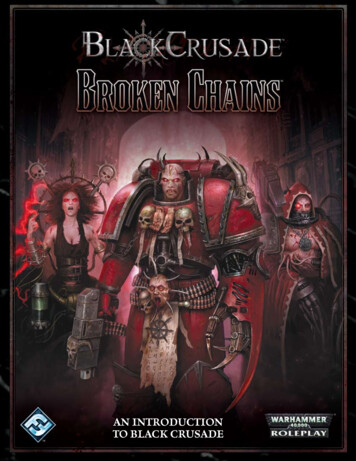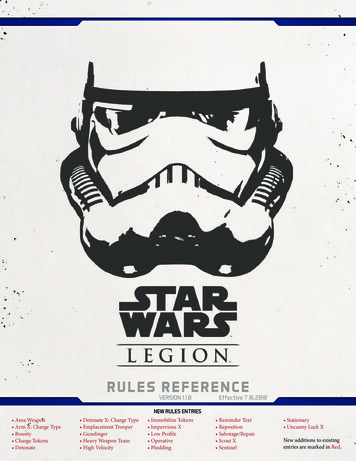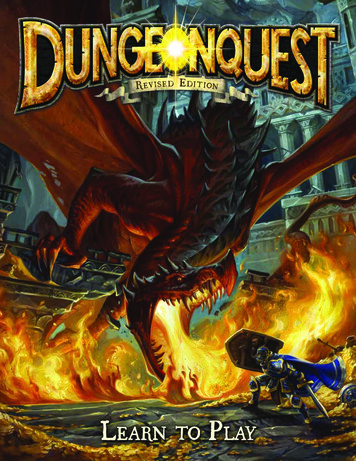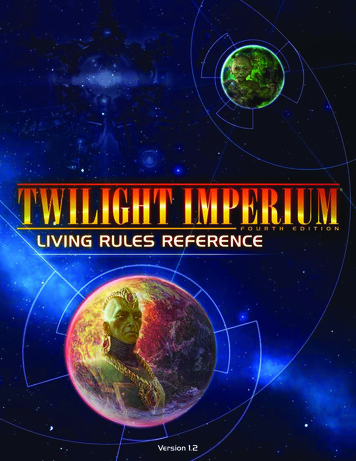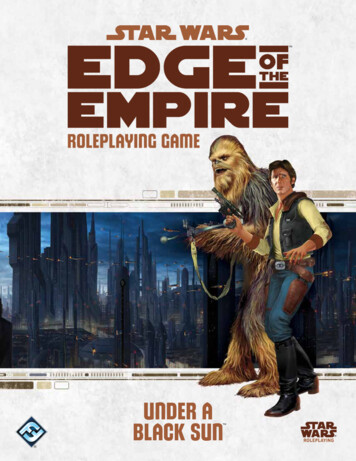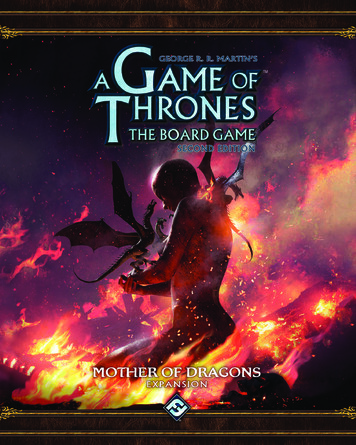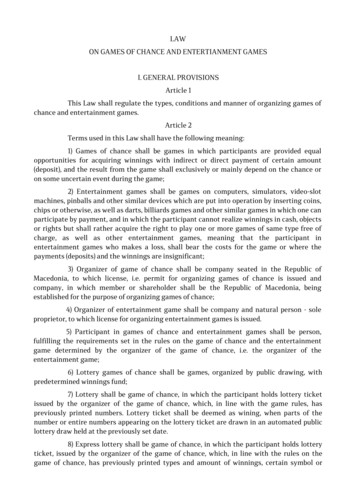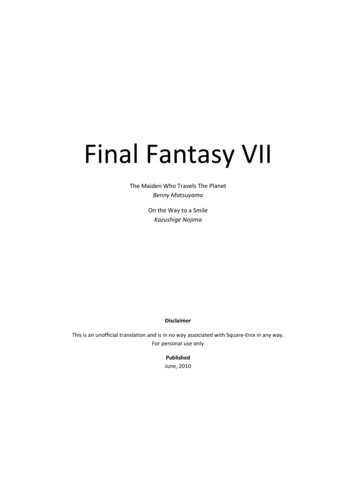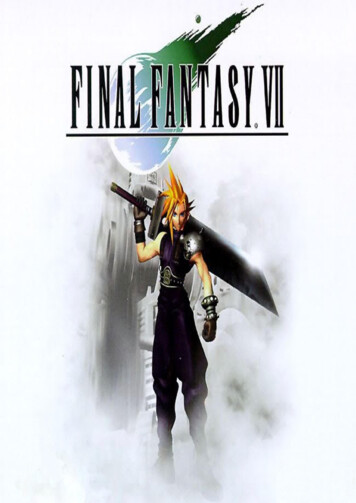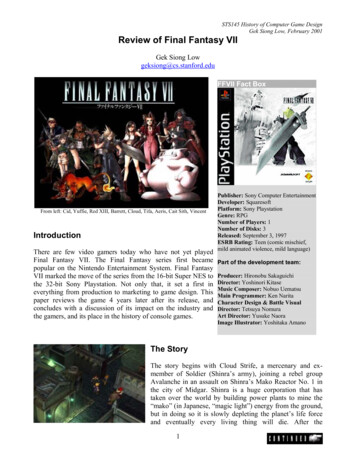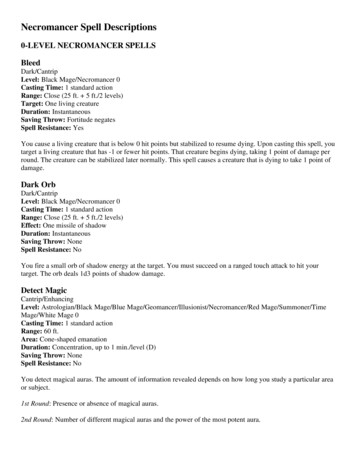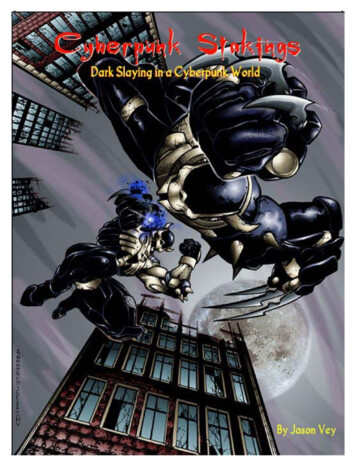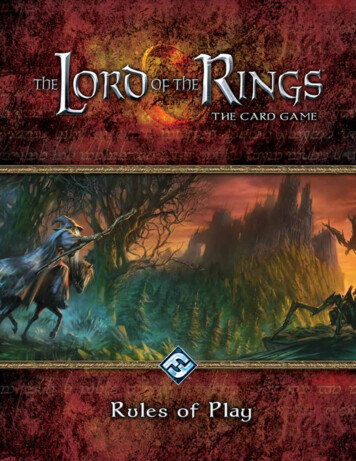
Transcription
IntroductionThe Living Card Game“You have done well to come,” said Elrond. “You willhear today all that you need to understand the purposeof the Enemy. There is naught that you can do, otherthan to resist, with hope or without it. But you do notstand alone. You will learn that your trouble is but partof the trouble of all the western world.”–from the chapter “The Council of Elrond”The Lord of the Rings,The Fellowship of the RingThe Lord of the Rings: The Card Game is a one totwo player game that can be played using only thecontents of this core set. (Up to four players can playthe game cooperatively with a second copy of the coreset.) In addition, The Lord of the Rings: The CardGame is a Living Card Game , and the enjoymentand experience of the game can be customized andenhanced through the purchase of regularly released60 card expansions called Adventure Packs. EachAdventure Pack provides players with new optionsand strategies for their decks (see page 27), as wellas an entirely new scenario against which to play.Additionally, deluxe Quest Packs introduce new areasof Middle-earth in which players can journey, explore,and seek new adventures. The Lord of the Rings: TheCard Game can be played both casually, with friends,or through the organized play program that is officiallysanctioned by Fantasy Flight Games.Welcome to Middle-earth, a land of Hobbits, Elves,Dwarves, Wizards, and Men. From the bright townsand fields of the Shire, to the wilds of MirkwoodForest and Rhovanion, and to the powerful kingdomsof Gondor and Rohan, the various peoples of this landstruggle against the foul minions and the ancient, evilthreat of the Dark Lord, Sauron.Game OverviewThe Lord of the Rings: The Card Game is a game ofheroes, perilous journeys, and adventure set in thelands described in the epic fantasy masterpiece createdby J.R.R. Tolkien, The Lord of the Rings. In this game,players take on the role of a party of heroes whoare attempting to complete dangerous quests. Thesequests take place during a timespan of 17 years: fromwhen Bilbo celebrates his 111th birthday (and Frodo’s33rd) to days just prior to Frodo’s leaving the Shire.Instead of directly retelling the classic stories that havepreviously been narrated, this game provides playerswith a variety of elements—characters, settings,enemies, events, items, artifacts, scenarios—that allowthem to embark upon new adventures and share newexperiences with the beloved The Lord of the Ringscharacters and settings during this period of Middleearth history.Unlike most card games, in which the players competeagainst each other, The Lord of the Rings: The CardGame is a cooperative game in which the playerswork together, competing against a scenario that is runautomatically by the game. In each game the playersattempt to overcome the particular encounters, enemies,and challenges of a scenario, against which they eitherwin or lose together.2
Component OverviewThe Lord of the Rings: The Card Game core setincludes the following components: This Rulebook 226 cards, consisting of: 12 Hero Cards 120 Player Cards 84 Encounter Cards 10 Quest CardsThreat TrackersThreat trackers are used to track a player’s threat levelthroughout the game. Threat represents the level of riska player has taken on during a scenario. If a player’sthreat level reaches a certain threshold, that player iseliminated from the game. A player’s threat level canalso draw out enemy encounters and set off unfortunatecircumstances throughout the course of the game.To assemble a threat tracker, use the plastic dialconnectors to attach two dials to each faceplate asshown in the diagram below. 2 Threat Trackers (each consisting of 1 faceplate, 2dials, and 4 plastic dial connectors) 40 Damage Tokens 26 Progress Tokens 30 Resource Tokens 1 First Player TokenCardsThe Lord of the Rings: The Card Game core setfeatures 226 cards. Four starter decks, each builtaround a distinct sphere of influence (Leadership, Lore,Spirit, and Tactics), can be played right out of the boxin the introductory game, or the cards in these deckscan be combined together to create tournament legaldecks. Also included in this set are 3 scenarios and 84encounter cards for the players to compete against. Fora complete explanation of each card type, seepages 5-9.Damage andProgress TokensDamage tokens representphysical damage that hasbeen inflicted on charactersand enemies. Progresstokens represent progressthat has been made on aquest.Resource TokensThese tokens represent thevarious resources at a hero’sdisposal. Resource tokensare collected by a player’sheroes, and are usedthroughout the game to payfor cards and card effects.First PlayerTokenThe first player tokendetermines which playeracts first each phase. Atthe end of each round, thefirst player token passesclockwise to a new player.3
Gameplay OverviewIn each game of The Lord of the Rings: The CardGame, players begin by choosing a scenario, and thenwork together in an attempt to complete it. A scenariois completed by successfully moving through all stagesof the quest deck. During a scenario, the encounterdeck aims to harm the heroes and to raise each player’sthreat level. A player is eliminated from the game ifall of his heroes are destroyed, or if his threat levelreaches 50. If all players are eliminated from the game,the players have lost. If at least one player survives andcompletes the final stage of the quest deck, all playersare victorious.Spheres of InfluenceThere are four different spheres of influence in TheLord of the Rings: The Card Game, and each has itsown distinct flavor and identity. Most player cards fallunder one of these spheres, represented by a uniqueicon, as well as by a unique color on its card border.Each hero has an emphasis in one of these four spheres.A hero’s sphere dictates the types of cards that heroallows a player to use.LeadershipThe sphere of Leadershipemphasizes the charismaticand inspirational influenceof a hero, and that hero’spotential to lead, inspire, andcommand both allies andother heroes alike.LoreThe sphere of Loreemphasizes the potentialof a hero’s mind. Intellect,wisdom, experience, andspecialized knowledge areall under the domain ofthis sphere.4SpiritThe sphere of Spiritemphasizes the strength of ahero’s will. Determination,resilience, courage, loyalty,and heart are all aspects ofthis sphere.TacticsThe sphere of Tacticsemphasizes a hero’s martialprowess, particularly as itrelates to combat and toovercoming other tacticalchallenges that mightconfront the players duringa quest.The Golden RuleIf the game text of a card contradicts the text of thisrulebook, the text on the card takes precedence.
Decks and Card TypesCard Anatomy Key - The Quest DeckThere are three different types of decks in The Lordof the Rings: The Card Game: the quest deck, theencounter deck, and the player deck. There are alsohero cards, which do not belong to any deck. Each deckhas its own function and its own set of card types, asdescribed below. In the game, each player plays oneplayer deck, and the players work together to movethrough a fixed quest deck. A randomized encounterdeck operates in conjunction with the quest deck ineach scenario to challenge the players as they playagainst the game.The Quest DeckEach scenario represents a quest that the players areattempting to complete. At the beginning of a game,the players must choose which scenario they wish toplay against for that game. A scenario consists of asequential deck of quest cards (referred to as “the questdeck”) and a randomized encounter deck of enemy,location, treachery, and objective cards. For moreinformation on the scenarios in this core set, seepage 26.Quest CardsEach quest card represents one of the various stages ofthe quest the players are pursuing in a scenario. Eachquest card is a numbered step in a fixed, sequentialorder. These cards have their sequential informationprinted on both sides, so they can be placed in thecorrect order without spoiling the contents of the latterstages in the scenario. Side A is the back of the card,and provides story and setup information. After readingand following any instructions on Side A, players flipthe card to Side B. Side B contains the informationnecessary to move to the next stage of the quest.31. Card Title: The name of this card. Each sequentialstage in a scenario has its own unique name.2. Scenario Symbol: A visual icon that identifies thisscenario, matching it to a subset of encounter cards.3. Sequence: This number determines the order inwhich the scenario deck is stacked at the beginning ofthe game. When setting up, card 1A is placed on top,followed by 2A, 3A, and so forth. Players proceed fromside A to side B on each stage of a scenario.4. Encounter Information: A group of icons that,along with the scenario symbol, identify whichencounter cards should be shuffled into the encounterdeck when playing this scenario.5. Scenario Title: The name of this scenario.6. Game Text: Story, setup instruction, special effects,or conditions that apply during this stage of thescenario.7. Set Information: Every card has an icon denotingthe set it belongs to, as well as a unique identificationnumber within the set.8. Quest Points: The number of progress tokens thatmust be placed on this card in order to proceed to thenext stage of the scenario.38152615274675
The Encounter DeckEnemy CardsThe encounter deck represents the villains, hazards,places, and circumstances that stand between theplayers and the successful completion of their quest.An encounter deck consists of enemy, location, andtreachery cards. The contents of the encounter deck aredetermined by the scenario the players are attempting(see “Scenario Overview” on page 26). The encounterdeck is shuffled at the beginning of the game.Enemy cards represent the villains, creatures, monsters,and minions that attempt to capture, destroy, or misleadthe heroes as they pursue their quest. Enemy cardsengage individual players and remain in play until theyare defeated.Card Anatomy Key - TheEncounter Deck1. Card Title: The name of this card.2. Engagement Cost: This number determines whenthis enemy card will move from the staging area andengage a player.3. Threat Strength ( ): The degree of danger thisenemy or location represents when it threatens theplayers from the staging area.2345125. Defense Strength (Ú): The effectiveness of thisenemy when it defends.6. Quest Points: The number of progress tokens thatmust be placed on this location to fully explore thelocation and discard it from play.7. Hit Points: The amount of damage required todestroy this card.8. Encounter Set Icon: Indicates which set ofencounter cards this card belongs to. Used inconjunction with the “Encounter Information” iconson side A of the quest cards of any scenario todetermine which encounter sets are used to build theencounter deck.974. Attack Strength (Û): The effectiveness of thisenemy when it attacks.8113Location CardsLocation cards represent the perilous places to whichthe players may travel during a scenario. They are adistant threat to the players from the staging area (seepage 10), and during the course of the quest playersmay opt to travel to a location to confront its threat.9. Traits: Text designators that, while carrying no rulesin themselves, may be affected by other cards in play.10. Game Text: The special abilities unique to thisparticular card when it is in play.1311. Shadow Effect Icon: If a card has a shadoweffect, that effect is denoted by this icon, which alsoserves to separate the shadow effect from the card’s inplay effect.12. Card Type: Indicates whether this card is anenemy, location, treachery, or objective.13. Set Information: Every card has an icon denotingthe set it belongs to, as well as a unique identificationnumber within the set.14. Scenario Title: The name of the scenario to whichthis objective card belongs.69861213
Treachery CardsObjective CardsTreachery cards represent traps, curses, maneuvers,pitfalls, and other surprises the players might confrontduring a scenario. When a treachery card is revealedfrom the encounter deck, its text effects are resolvedimmediately, and it is then placed in the encounterdiscard pile.Depending on the scenario, objective cards canrepresent a number of different elements, ranging fromthe goals of a scenario, to allies who assist the players,to keys that allow the players to advance to the nextstage of a quest, to artifacts that are necessary to defeata difficult enemy or overcome a particular challenge.Unless otherwise specified, objective cards are shuffledinto the encounter deck when setting up a scenario.111489811121312137
Hero CardsHero cards represent the main characters a playercontrols in an attempt to complete a scenario. Heroesstart in play, and they provide the resources that areused to pay for the cards (allies, attachments, andevents) in a player’s deck. Heroes can also commit toquests, attack, defend, and in many cases they bringtheir own card abilities to the game. Each playerchooses 1-3 hero cards and starts the game with themin play.31. Card Title: The name of this card. A card with a‰ symbol next to its name is unique. (See “UniqueCards,” page 8.)2. Cost: The number of resources a player must spendfrom the appropriate resource pool(s) to play this cardfrom his hand. Cost is not found on hero cards.3. Threat Cost: Found only on hero cards, this numberis the amount of threat a player must add to his threattracker at the beginning of any game in which he isusing this hero.4. Sphere of Influence Icon: Indicates which spherethis card belongs to. The card’s template color alsoindicates this. Neutral cards have a grey template andno sphere of influence icon.5675. Willpower Strength (Ò): The effectiveness of thischaracter when it commits to a quest.6. Attack Strength (Û): The effectiveness of thischaracter when it attacks.17. Defense Strength (Ú): The effectiveness of thischaracter when it defends.8119Unique Cards1213Some cards in this game represent specific,formally named characters, locations, and items fromthe Middle-earth setting. These cards are referredto in the game as “unique.” They are marked witha ‰ symbol before their card title to indicate theiruniqueness.If any player has a unique card in play, no player canplay or put into play another card with the same title.Any attempt to do so will fail to the extent that the cardattempting to enter play remains in its current location(hand, deck, discard pile) and does not enter play. Thisrule applies to all unique hero, ally, attachment, andevent cards that might enter play. Note that a uniquecard is eligible to enter play if another card with thesame title is in a player’s discard pile but not currentlyin play.Multiple copies of the same non-unique card can be inplay simultaneously.8Card Anatomy Key - Hero Cards andThe Player Deck8. Hit Points: The amount of damage required todestroy this card.9. Resource Icons: Found only on hero cards, theseicons indicate the sphere(s) of influence to whichresource tokens in this hero’s resource pool belong.They also indicate to which sphere(s) the hero carditself belongs.10. Traits: Text designators that, while carrying norules in themselves, may be affected by other cards inplay.11. Game Text: The special abilities unique to thisparticular card. Some cards have italicized flavor text,featuring quotations from The Lord of the Rings novels.12. Card Type: Indicates whether this card is a hero,ally, attachment, or event.13. Set Information: Every card has an icon denotingthe set it belongs to, as well as a unique identificationnumber within the set.Character CardsSometimes, game or rules text will refer to “character”cards. Both heroes and allies are considered to be“characters.” Card text that says “choose a character”allows a player to choose either a hero or an ally cardas the target of the effect.
The Player DeckAlly CardsThe player deck includes a combination of ally,attachment, and event cards shuffled into a deck fromwhich a player draws his cards throughout the game.No more than three copies of any ally, attachment, orevent card, by title, can be included in a player’s deck.Each of the four 30-card starter decks in this core setcan be played out of the box as an introduction to thegame. For advanced play, the cards in these starterdecks can be combined with one another, or furtherdeveloped with cards from Adventure Pack expansions,to create 50-card tournament decks. (For more on theart of customizing a player deck, see “TournamentDeckbuilding and Customization,” page 27.)Ally cards represent characters (friends, followers,creatures, and hirelings) that assist a player’s heroes onthe quest. Ally cards are played from a player’s hand,and they remain in play until they are destroyed orremoved from play by a card effect.Attachment CardsAttachment cards represent weapons, armor, artifacts,equipment, skills, and conditions. When played, theyare always attached to (placed slightly under) anothercard, and they tend to modify or influence the activityof the card to which they are attached. If the cardto which an attachment is attached leaves play, theattachment card is discarded.25671411812132Event Cards1412Event cards represent maneuvers, actions, tactics,spells, and other instantaneous effects at a player’sdisposal. An event card is played from a player’s hand,its text effects are resolved, and the card is then placedin its owner’s discard pile.11213141112139
For the First GameFor the first game, each player chooses one of the fourspheres of influence and uses the starter deck for thatsphere. The card numbers of each of the four spheresare listed below. Each sphere is also listed with thethree heroes that should be used with that starter deck.The players determine a first player based on amajority group decision. If this proves impossible,determine a first player at random. Once determined,the first player takes the first player token and places itin front of him as reference.Leadership (cards 13-27; heroes Aragorn, Glóin,Théodred)5. Draw Setup HandTactics (cards 28-42; heroes Legolas, Gimli, Thalin)Spirit (cards 43-57; heroes Éowyn, Dunhere, Eleanor)Lore (cards 58-72; heroes Glorfindel, Denethor,Beravor)Each starter deck should also include 1 copy of theneutral ally card, Gandalf (card 73).Next, the players select a scenario they would like toplay. For the first game, players should try the “PassageThrough Mirkwood” scenario, which was designed asan introductory scenario. Separate the cards for thisscenario (see page 26). These consist of the quest cards(numbered 120-123), and the encounter cards markedwith the Passage Through Mirkwood, Spiders ofMirkwood, and Dol Guldur Orcs symbols (seepage 26).Each player draws 6 cards from the top of his playerdeck. If a player does not wish to keep his startinghand, he may take a single mulligan, by shufflingthese 6 cards back into his deck and drawing 6 newcards. A player who takes a mulligan must keep hissecond hand.6. Set Quest CardsArrange the quest cards in sequential order, based offthe numbers on the back of each card. Stage 1A shouldbe on top, with the numbers increasing in sequencemoving down the stack. Place the quest deck near theencounter deck, in the center of the play area.7. Follow Scenario Setup InstructionThe back of the first quest card sometimes providessetup instructions for a scenario. Follow theseinstructions before flipping the quest card.For tournament deckbuilding rules, see page 27.Players then begin the game starting with the firstgame round.Playing the GameThe Staging AreaSetupBefore playing The Lord of the Rings: The Card Game,follow these quick steps in order.1. Shuffle DecksAs with a deck of playing cards, shuffle all playerdecks and the encounter deck separately until they arerandomized. Do not shuffle the quest cards into theencounter deck, and do not shuffle the hero cards intothe player decks.2. Place Heroes and Set Initial Threat LevelsEach player places his heroes in front of him, addsup the threat cost of the heroes he controls, and setshis threat tracker at the same value. This value is thatplayer’s starting threat level for the game.3. Setup Token BankPlace the damage tokens, progress tokens, and resourcetokens in a pile next to the encounter deck. All playerstake tokens from this bank as needed throughoutthe game.104. Determine First PlayerThe staging area is a unique element of the game’splaying field. It represents the potential dangers theplayers might face as they progress on their quest.During the quest phase, enemy and location cards arerevealed from the encounter deck and placed in thestaging area. Cards in the staging area are imminentthreats to the players, including enemies that need tobe defeated and locations that need to be explored.While a location is in the staging area, the players arenot considered at that location; instead it represents adistant threat. Players have the option of traveling to alocation during the travel phase. Similarly, enemies inthe staging area are not yet engaged with any of theplayers. Enemies engage players when a player’s threatlevel is high enough to draw out that enemy. Playersalso have the option to voluntarily engage enemiesduring the encounter phase. (For more on engagingenemies and traveling to locations, see pages 15-16).Discard PilesEach player has his own discard pile, and the encounterdeck also has its own discard pile. Whenever a card isdiscarded, it goes to the discard pile belonging to thecard’s originating deck.
Suggested Play Field SetupTom s Threat DialTom s HeroesEnemy Engagedwith TomTom s PlayerDeckTom s DiscardPileToken BankEncounterDeckEncounterDiscard PileFirst PlayerTokenKris s Player DeckKris s AllyKris s HeroesEnemy Engagedwith KrisStagingAreaQuest DeckKris s ThreatDialKris s Discard Pile11
Round SequenceThe Lord of the Rings: The Card Game is played over aseries of rounds. Each round is divided into 7 phases.Some phases are played simultaneously by all players,while in other phases the players act separately,with the first player acting first and play proceedingclockwise around the table.The 7 phases are, in order:1. Resource2. Planning3. Quest4. TravelIf a hero is exhausted (see page 14), resources may stillbe spent from that hero’s resource pool.Cards with a cost of zero do not require a resource to bespent in order to pay their cost, but they do requireat least one hero under that player’s control to have aresource icon that matches the card’s sphere.After a player plays an ally or attachment card fromhis hand, he places it faceup and ready in his playarea. Attachment cards should be placed partiallyoverlapping, either above or below, the card to whichthey are attached.If a player has multiple heroes with similar resourceicons, he may use resources from multiple pools of thesame sphere to pay for a single card or effect.5. Encounter6. Combat7. RefreshOnce all 7 phases are complete, the round is over, andplay proceeds to the resource phase of the next round.A turn sequence diagram of all the phases, and thegame events that occur during each phase, can be foundon pages 30-31 of this rulebook.Phase 1: ResourceEach player simultaneously adds 1 resource token toeach of his heroes’ resource pools. A resource pool isa collection of resource tokens stored near a hero card.These tokens belong to that hero’s pool, and can beused to pay for cards that belong to that hero’s sphereof influence. Each hero has 1 resource pool.After collecting resources, each player draws 1 cardfrom his player deck and adds it to his hand.When a player is instructed to draw one or morecards, he always draws those cards from the top of hisown player deck. If a player has no cards remaining inhis player deck, he does not draw.Example: Tom has 3 heroes: Glóin (who hasa Leadership resource icon and 3 resourcesin his pool), Éowyn (who has a Spiritresource icon and 2 resources in her pool),and Eleanor (who has a Spirit resource iconand 2 resources in her pool). Tom wishes toplay the Guard of the Citadel card from hishand. The Guard of the Citadel belongs tothe Leadership sphere, so Tom must spendresources from Glóin’s pool to play this card.Since the Guard of the Citadel has a cost of2, Tom moves 2 resources from Glóin’s poolto the token bank and places the Guard of theCitadel into his play area. Tom also wishes toplay the Northern Tracker card from his hand,which belongs to the sphere of Spirit, andhas a cost of 4. To play this card, Tom takes 2resources from Éowyn’s pool, and 2 resourcesfrom Eleanor’s pool, for a total of 4. He cando this because both Éowyn and Eleanor haveSpirit resource icons. Tom spends these tokensand places them in the token bank, and thenplaces the Northern Tracker in his play area.(See diagram on page 13.)Phase 2: PlanningThis is the only phase in which a player can play allyand attachment cards from his hand. The first playerplays any and all ally and attachment cards he wishes toplay first. The opportunity to play cards then proceedsclockwise around the table.In order for a player to play a card from his hand (orto activate certain card effects), he must pay for it byspending resource tokens from the resource pool of ahero who has a resource icon that matches the card’ssphere of influence. This is called a resource match.Resources that are spent to pay for cards or card effectsare taken from their hero’s resource pool and placed inthe general token bank.12Paying for Neutral CardsNeutral cards, which belong to no sphere of influence,require no resource match to play. This means that theycan be payed for with resources from any hero’s pool.Also, when paying for a neutral card, a player maycombine resources from heroes with different resourceicons. Gandalf is the only neutral card in the core set.Paying for Card AbilitiesSome cards have abilities that can be triggered fromplay, but still require the triggering player to payresources. Triggering a card ability from a card alreadyin play requires no resource match, unless otherwisespecified by the ability.
Example: Paying for Cards123(to token bank)(from player s hand)(from player s hand)(to token bank)1. Glóin has a Leadership resource icon and 3 resource tokens in his resourcepool. Éowyn and Eleanor each have a Spirit resource icon, and 2 resource tokensin their resource pools.2. To play the Guard of the Citadel from his hand, Tom spends 2 resource tokensfrom Glóin’s pool, returning the tokens to the token bank. 1 resource tokenremains unspent in Glóin’s resource pool.3. To play the Northern Tracker from his hand, Tom spends 2 resource tokensfrom Éowyn’s resource pool and he spends 2 resource tokens from Eleanor’sresource pool, returning the tokens to the token bank.13
Ready and ExhaustedPhase 3: QuestCharacters and attachment cards enter the game in the“ready” position–that is, faceup on the playing surfacein front of their controller.In the quest phase, the players attempt to make progresson the current stage of their quest. This phase is brokeninto three steps: 1) commit characters, 2) staging, and3) quest resolution. Players have the opportunity to takeactions and play event cards at the end of each step.When a card has been “used” for some purpose, suchas to commit to a quest, to attack, to defend, or to usea character ability that requires the card to exhaust,it is turned 90 degrees sideways and considered“exhausted.” An exhausted card cannot exhaust again(and therefore cannot partake in any action thatrequires exhaustion) until it has been readied oncemore. When a player is instructed by the game or bya card effect to ready a card, he moves that card to itsnormal upright position.ReadyExhaustedStep 1: Commit CharactersEach player may commit characters to the current questcard. Characters are exhausted when they commit toa quest. Players commit characters to the quest as ateam, starting with the first player, and then proceedingclockwise around the table. Each player may commit asmany of his characters to the quest as he would like.Step 2: StagingAfter each player has had the opportunity to commitcharacters to the quest, the encounter deck revealsone card per player. This is known in the game asstaging. These encounter cards are revealed one at atime, with any “when revealed” effects being resolvedbefore the next card is revealed. Enemy and locationcards revealed in this manner are placed in the stagingarea, treachery cards are resolved and (unless otherwiseindicated by the card text) placed in the discard pile.If the encounter deck is ever empty during the questphase, the encounter discard pile is shuffled and resetback into the encounter deck.Step 3: Quest ResolutionFinally, the players compare the combined willpowerstrength (Ò) of all committed characters against thecombined threat strength ( ) of all cards in the stagingarea.If the Ò is higher, the players have successfullyquested, and they make progress on the quest. Anumber of progress tokens equal to the amount bywhich their Ò overcame the are placed on thecurrent quest card. Note that if there is an activelocation (see page 15), progress tokens are placed onthat location until it is explored, and the remainder arethen placed on the current quest.If the is higher, the players have unsuccessfullyquested, and they are driven back by the encounterdeck. Each player must raise his threat dial by theamount by which the was higher than the combinedÒ of all committed characters.If the combined committed Ò score is equal to thecombined score in the staging area: no progresstokens are placed, and the players do not increase theirthreat dials.Characters committed to a quest are consideredcommitted to that quest through the end of the questphase, unless removed from the quest by a card effect.They do remain exhausted once this step is complete.14
Example: Resolving a QuestKris s PlayArea13Tom s PlayArea2Staging
A hero’s sphere dictates the types of cards that hero allows a player to use. Leadership The sphere of Leadership emphasizes the charismatic and inspirational influence of a hero, and that hero’s potential to lead, inspire, and command both allies and other heroes alike. Lore The sphere of Lore em
